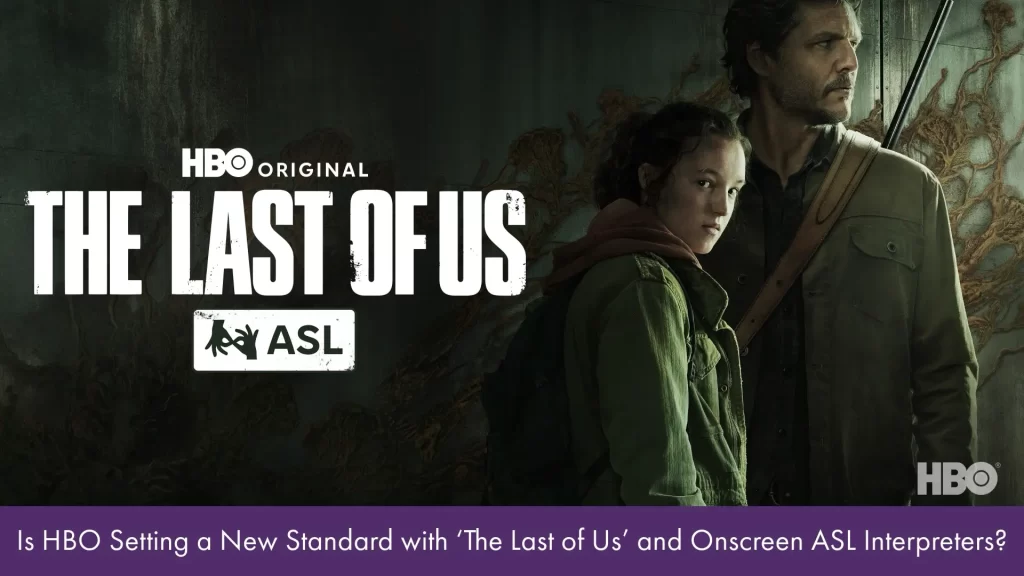Not sure if you were watching last night, but HBO just made accessibility history.
With the premiere of The Last of Us Season 2, viewers now have the option to watch each episode with a real-time onscreen ASL Interpreter—a huge step forward in creating equal access to high-quality storytelling. The inclusion of an ASL Interpreter gives Deaf and hard-of-hearing audiences an experience that’s both immersive and respectful.
But if you’ve followed The Last of Us from its video game roots, this shouldn’t surprise you.
A Legacy of Accessibility: From Console to Cable
Before The Last of Us was a hit show on HBO, it was one of the most celebrated video games of its time. Developed by Naughty Dog and published by PlayStation Studios, the game wasn’t just known for its emotional storytelling and gritty realism—it was praised as one of the most accessible video games of all time.
The original game and its sequel, The Last of Us Part II, was loaded with inclusive features that allowed people with a wide range of disabilities to play. From high-contrast display modes and extensive audio cues to full control remapping and navigational assistance, these features set a new industry benchmark for accessible design.
I had the honor and privilege to meet with the creators of the video game years ago, when they were still building their foundation for accessibility. I shared my own lived experiences with them—what I needed, what I appreciated, and what could still be improved. And let me tell you, they were not only receptive, they were passionate about getting it right.
That commitment is now clearly reflected in the show’s new ASL Interpreter feature—a move that honors the legacy of accessibility established in the game.
An Onscreen ASL Interpreter: Why It Matters
This isn’t a case of closed captions or off-screen interpreters. HBO has collaborated with Deaf creatives and accessibility advocates to embed a real-time ASL interpreter directly into the corner of the screen. And it’s available exclusively through Max’s web platform, where viewers can select the ASL version of each episode.
According to HBO’s announcement, the move was done “with the Deaf and hard-of-hearing community in mind,” and it represents a unique partnership between entertainment platforms and accessibility-forward organizations. The interpreter isn’t an afterthought or a feature buried in submenus. Instead, it’s treated with the respect and visibility it deserves.
In fact, the interpreter’s presence is woven into the experience in a way that supports immersion—not distraction. It’s not about making ASL an optional extra. It’s about saying: you deserve to be here too.
Representation Isn’t a Trend—It’s a Responsibility
What The Last of Us does so well is recognize that accessibility is not just a checklist item—it’s a core part of the creative process. This isn’t their first inclusive move, and it won’t be their last.
From the casting of Deaf actor Keivonn Montreal Woodard as Sam in Season 1, to the careful portrayal of disability in both the show and the game, The Last of Us consistently shows that diversity in storytelling goes beyond what’s easy or obvious. It takes work. It takes listening. And it takes an unwavering belief that everyone should be able to see themselves in the world of fiction—whether through subtitles, audio descriptions, or an ASL Interpreter.
For those of us in the disability community, this kind of change doesn’t just make us feel seen—it makes us feel valued.
A Model for the Industry
The success of The Last of Us—both as a game and as a show—proves that accessibility and artistic integrity are not mutually exclusive. In fact, they’re deeply connected.
This new ASL Interpreter option on HBO Max should be a wake-up call for the rest of the entertainment industry: if one of the most cinematic, high-stakes shows on television can integrate an ASL Interpreter, so can everyone else.
The ASL interpreter version is not a gimmick or a marketing ploy. It’s an invitation for other studios, networks, and platforms to step up and meet audiences where they are. It’s proof that accessibility can be embedded into content from day one, and that inclusive design leads to better storytelling for everyone.
As someone who has spent their life pushing for accessibility in digital, physical, and social spaces, I can’t help but smile at this moment. It’s not perfect. There’s still so much work to do. But this? This is a big deal.
Let’s Keep It Going
I’ve said it before, and I’ll keep saying it: true accessibility is built through conversation, collaboration, and compassion. What HBO and the creators of The Last of Us have done here is lead by example—and I’m hopeful others will follow.
If you work in media, design, tech, or entertainment and want to explore what accessibility could look like in your world, we’d love to talk with you. Because when we make space for everyone, we all win.
Want to make your content, brand, or experience more inclusive? Let’s connect. We’re ready to help you build something everyone can enjoy.


